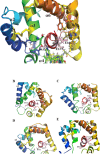Pheromone-Binding Proteins in Pest Control: From Molecular Insights to Real-World Applications
- PMID: 40836761
- PMCID: PMC12412164
- DOI: 10.1021/acs.jafc.5c03663
Pheromone-Binding Proteins in Pest Control: From Molecular Insights to Real-World Applications
Abstract
Insects utilize sophisticated olfactory systems to detect chemical cues critical for behaviors such as mating, host selection, and predator avoidance. In lepidopteran moths, sex pheromone communication offers a well-established model in which males detect female-emitted signals over long distances. Central to this process are pheromone-binding proteins (PBPs), which solubilize and transport hydrophobic pheromones through the sensillar lymph to olfactory receptors, enabling precise signal detection. Recent advances in molecular biology, structural biochemistry, and gene-editing technologies such as CRISPR/Cas9 have uncovered nuanced mechanisms underlying PBP function, including ligand-binding specificity, pH-dependent conformational dynamics, and molecular interactions. These discoveries have broad implications, extending beyond chemosensory biology to applications in reverse chemical ecology, biosensing, and environmentally conscious pest control. This review synthesizes insights from in vitro, in silico, and in vivo studies, highlighting the structural and functional diversity of PBPs across species and emphasizing their translational utility as molecular targets for sustainable agriculture and biodiversity conservation.
Keywords: integrated pest management (IPM); lepidopteran sex pheromones; ligand binding; odorant-binding proteins (OBPs); olfaction in insects; olfactory receptors (ORs); pest control strategies; pheromone-binding proteins (PBPs); signal transduction.
Figures










References
-
- Greenfield M. D.. Moth Sex-Pheromones - an Evolutionary Perspective. Fla Entomol. 1981;64(1):4–17. doi: 10.2307/3494597. - DOI
-
- Honson N., Gong Y., Plettner E.. Structure and function of insect odorant and pheromone-binding proteins (OBPs and PBPs) and chemosensory-specific proteins (CSPs) Recent Advances in Phytochemistry. 2005;39(05):227–268. doi: 10.1016/S0079-9920(05)80010-3. - DOI
Publication types
MeSH terms
Substances
LinkOut - more resources
Full Text Sources
Research Materials
Miscellaneous

